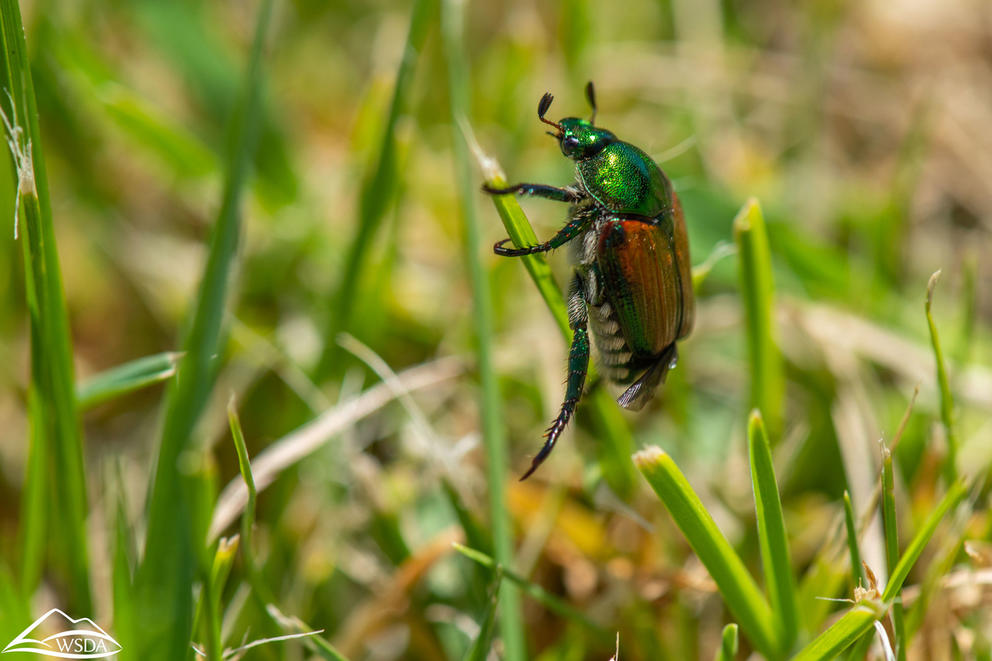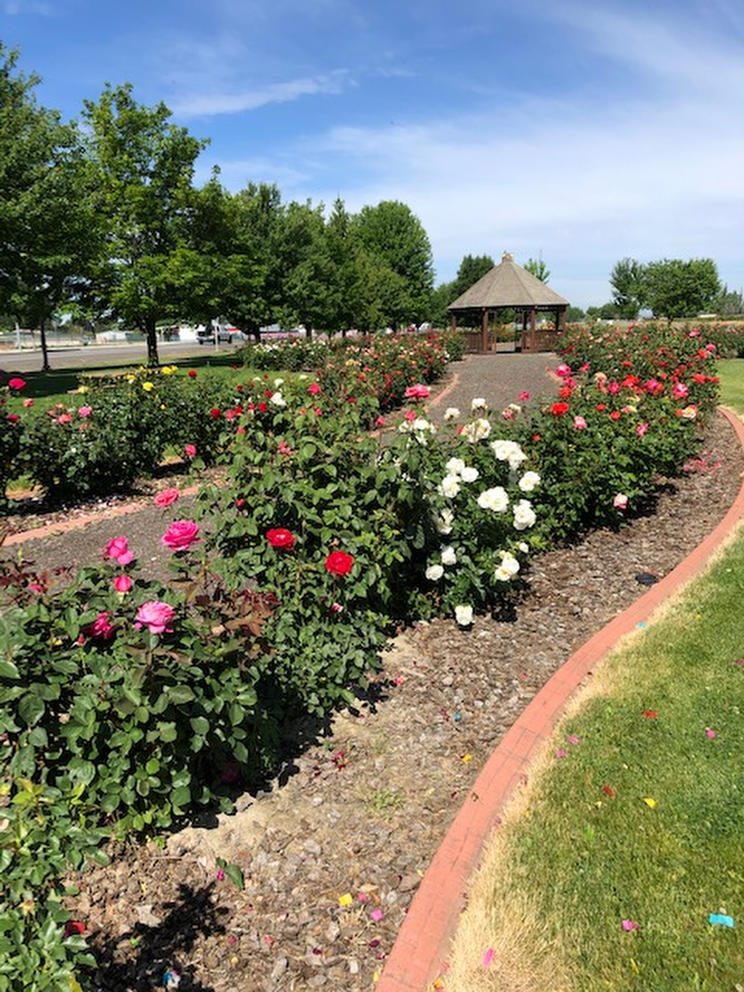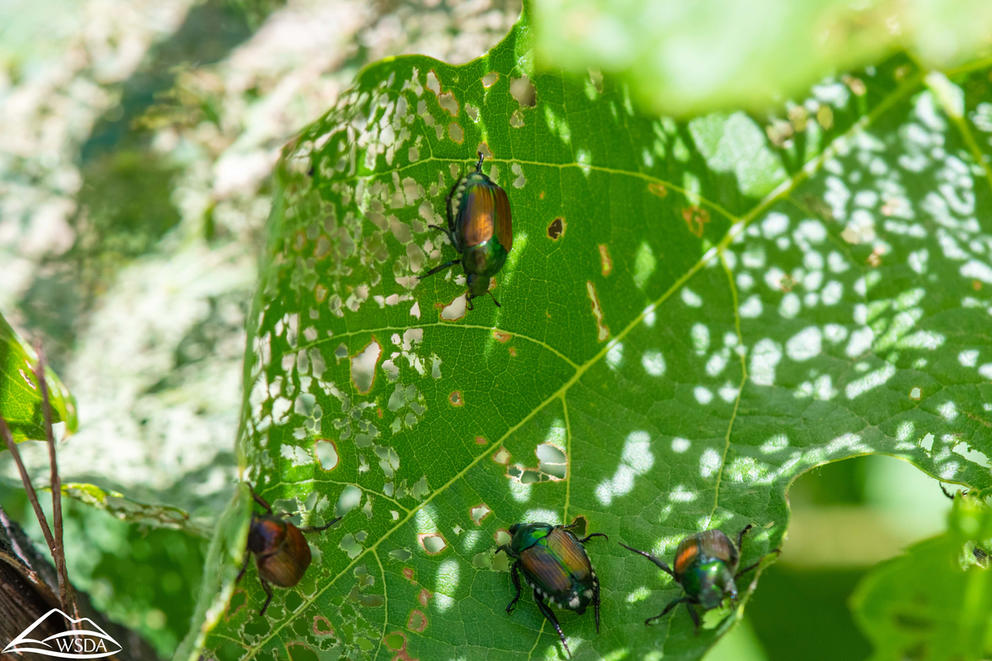It’s a common gathering place — its gazebo is a venue for weddings and quinceañeras.
But the garden’s bounty has attracted an unwelcome visitor: the Japanese beetle.
Ray Vining, who has lived in Grandview for several decades and volunteers at the garden, first heard about the invasive species two years ago through reports of damaged rose bushes and gardens in the area. The first beetle specimens in Grandview were also found on Wine Country Road, close to the rose garden.
Several beetles were collected in a trap installed within the garden a year later. Those collected specimens would be among the thousands spotted in the city of more than 11,000 people.
Thankfully, there has yet to be any damage to the garden, and Vining and other volunteers want to keep it that way.
That’s the hope of the Washington State Department of Agriculture, which is undertaking a multimillion, multiyear trapping, quarantining and eradication process to get rid of the beetle, which originated in Japan and made its presence first known in the eastern U.S. in the early 20th century.
“Because it’s an invasive species — it doesn’t have any local predators [to eat them] — they can grow and multiply quickly and cause excessive damage,” Vining said.
Another outbreak starts in 2020
The spring of 2020 will forever be known as the start of the COVID-19 pandemic, but the state experienced a different outbreak that year.
During its annual survey, the state Department of Agriculture caught a Japanese beetle in Sunnyside in the southeast part of Yakima County.
The beetle, also known by its scientific name, Popilla japonica, is named for its Asian country of origin. However, the common Japanese beetle name might be a candidate for review in response to concerns that it stokes anti-Asian and xenophobic sentiments. (See sidebar below.)
However, the beetle has been present in the eastern U.S. for more than 100 years and has established a widespread endemic population in several eastern and midwestern states, such as Michigan.
But the beetle is invasive in the Pacific Northwest, potentially causing ecological and economic harm in a new environment.
The beetle — which has a metallic green exterior and copper wing covers — had been spotted in several Washington counties in previous years. Still, those detections were associated with transport via air cargo and generally hadn’t resulted in established populations.
Since Sunnyside, a significant dairy production area, was not close to a major airport, detecting even a single beetle was concerning. And through further trapping efforts, two additional beetle specimens were found in Grandview, near the Grandview Rose Garden, at the end of the 2020 trapping season.
A few months later, an outreach effort for the state’s Invasive Species Awareness Week yielded a report from a Grandview resident of the presence of beetles in her flower garden. Then last summer, the state Agriculture Department managed to trap more than 24,000 adult beetles within a 49-square-mile area around the city of Grandview.
And the population of beetles — which fly around during the summer and early fall before dying — is likely bigger since specimens probaly escaped the traps, said Camilo Acosta, Japanese beetle eradication coordinator with the Agriculture Department.
The beetle can feed on 300 different plants, making Grandview a prime spot for a population to grow. Grandview growers produce several agricultural commodities, including cherries and hops, harvested during the beetle’s prime flight months.
Before dying, an adult beetle can lay upwards of 40 to 60 eggs on the ground. Those eggs hatch in the fall and develop by eating soil and other plant material on the ground during the spring before growing into adult beetles come summer.
The result is an exponential growth in the population, Acosta said.
“The beetle can sustain populations anywhere where it has a food source and a substrate to lay eggs, and that would be anywhere that has some grass,” he said.
Such growth is a concern for those in the agricultural industry or organizations or homeowners with landscaping and greenery that immature and adult beetles can feed on.
The larvae, or grubs, can “ugly up a golf course, playground or people’s yards,” said Doug Walsh, a professor of entomology and integrated pest management coordinator at Washington State University. Walsh is based at WSU's campus in Prosser, just a few miles east of Grandview. “The adults have an extremely wide range of host plants they could feed on, with hops one of the preferred hosts that have been documented back East.”
The beetles primarily feed on the leaves of some agricultural products, such as cherries. Those commodities can take minimal feeding, but repeated defoliation could stunt growth and yield.
Beetles also defoliate hops come harvest, but the beetle also strikes in other ways.
For one, the grubs and larvae can feed on the material around the hop bine, the climbing or twining stem of the plant, when it's first planted in the spring, potentially stunting growth.
By the fall months, when harvest comes, the adult beetle feeds on both the plant's leaves and hop cones, said Maggie Elliot, science and technical director of the Hop Growers of America, a Yakima-based organization representing the nation’s hop growers.
Walsh said agricultural commodities could also further spread the beetle while being transported.
Minimizing the outbreak
Because the beetle outbreak is limited to a localized area, the state Agriculture Department sees an opportunity to eradicate the beetle population.
To do this, the department plans to spray pesticides over the area. The hope is that beetles developing on the ground ingest the pesticides and die.
“When it’s brand new, and if it has not spread throughout an area, you can manage to prevent it from being a [bigger] problem,” said David Epstein, vice president for scientific affairs with the Northwest Horticultural Council, a Yakima-based organization that represents tree fruit growers in the Northwest in public policy issues.
Epstein previously worked as a tree fruit entomologist for 20 years and had done fieldwork at Washington State University and Michigan State University, which has done extensive work to manage beetle outbreaks.
It’s the first massive effort to eradicate the beetle in the state, said Acosta of the Agriculture Department.
The governor’s budget included about $4.7 million in supplemental funding for eradication and other efforts aimed at containing the outbreak of beetles in the Grandview area.
Other states have been successful in dealing with emerging beetle populations. The Idaho Department of Agriculture effectively eradicated a beetle population developing in downtown Boise. The area had up to 3,000 beetles in 2013. After a multiyear eradication effort, the number of beetles detected dropped to just four in 2018. No beetles were found in 2019, 2020 or 2021. The state agency hopes for a similar result with a new eradication effort in Pocatello.
A successful eradication effort in Washington state would require significant community buy-in. The state Agriculture Department must have consent from 3,500 households within the 49-square-mile area around Grandview where beetles were spotted during trapping last year to spray the pesticides Acelepryn G and Acelepryn on fields, parks, lawns and flower beds.
For the past two months, the department has engaged in a massive outreach effort that has included mailers, virtual and in-person open houses and door-to-door visits to homes located in an area with the highest number of beetle collections.
As of Tuesday, more than 500 households agreed to spraying. Outreach efforts will continue for several more weeks leading to the start of the eradication process, which will go from April through September.
Acosta said most have generally understood the need for the eradication effort. However, many have voiced concerns about the health impacts of spraying pesticides on their home lawns.
To address the issue, the Agriculture Department has worked with the Washington State Department of Health, which has a designated website to explain the importance of stopping the spread of Japanese beetles and provides information about the two pesticides.
The Department of Health says both pesticides have an excellent safety record and lists additional precautions one could take, including avoiding sprayed areas for several hours and washing any clothes that come into contact with the pesticides.
The Agriculture Department would also continue trapping adult beetles to monitor whether the outbreak has spread. To determine this, the department would expand the boundary of the trapping area and increase the number of traps used. The trapping season goes from May to October, coinciding with the peak flight of adult beetles.
The Agriculture Department won’t know the initial effectiveness of the eradication effort until at least the end of the 2023 trapping season. By then, the department can factor in the 2022 eradication season, Acosta said.
Meanwhile, the department hopes to complete rule-making on an interior quarantine, which would regulate the agricultural items transported out of the infected area in the coming months. The effort aims to limit the beetle’s spread while the state works on eradicating the beetle population in Grandview.
Part of that process is looking into potential economic impacts on businesses.
For example, the proposed language for hops says that any crop transported out of the quarantine area would have to be sprayed with Coragen, an insecticide known to be effective in controlling pests. That creates an additional expense in labor and materials for growers already experiencing increased production costs, said Elliot of the Hop Growers of America.
As a result, the organization has proposed an option to waive the requirement to spray Coragen for hops harvested from a field free of Japanese beetles, Elliot said.
Still, even if hops within the area are required to be sprayed with Coragen as part of the quarantine, there is some good news: The pesticide’s use is allowed in countries that import Washington-grown hops, Elliot said.
And the use of the pesticide has proved to be harmonious with other integrated pest management efforts in areas with a similar population of beetles.
“You don’t want to introduce a new problem,” she said.
What’s ahead
It will take several years to determine whether the eradication effort is successful.
If, as in other states, the beetle becomes an established pest in the Yakima Valley and elsewhere in the state, it will have an endemic population that needs to be dealt with every year.
The beetle's presence in other states provides some insight into the types of insecticides and practices necessary to prevent damage by the beetle, said Epstein of the Northwest Horticultural Council.
Epstein has seen one positive in working with growers in Michigan for a dozen years. Beetles there tend to congregate in one part of a yard or agricultural area and ignore the rest, he said. Other sites may be able to avoid the beetle entirely.
“It’s not something you expect to treat every year or on a routine basis,” he said. “It’s a spot problem.”
Still, eradication of the beetle is ideal. If nothing else, it’s one fewer pest for both agricultural producers and hobby gardeners to deal with, said Walsh of Washington State University.
“To be blunt, most farmers, most homeowners don’t want to spray [new] insecticides unless they need to,” he said. “It’s time; it’s expense; it’s effort.”
This story was updated to correct that the beetle arrived in the U.S. in the early 20th century. It was earlier updated to correct the spelling of the scientific name of the Japanese beetle, Popillia japonica.







